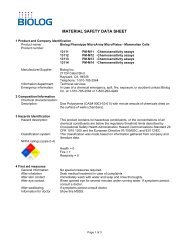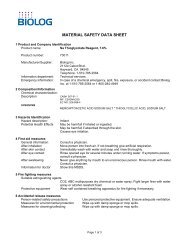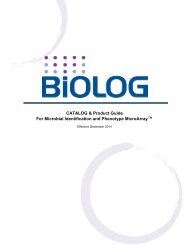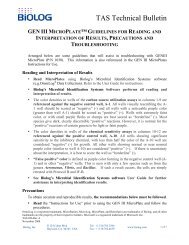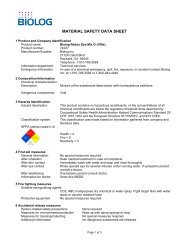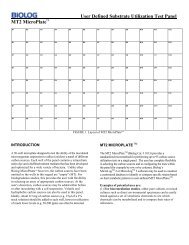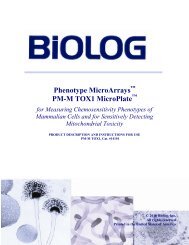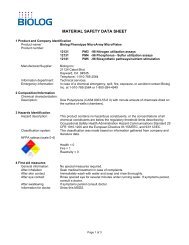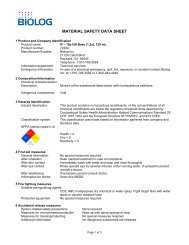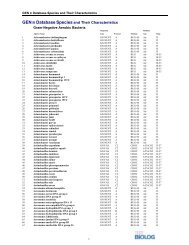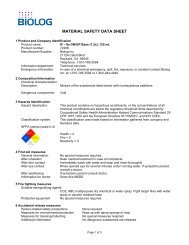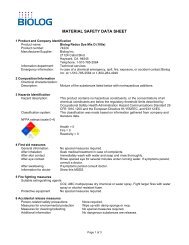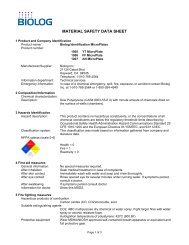GEN III Technology Overview - Biolog Inc.
GEN III Technology Overview - Biolog Inc.
GEN III Technology Overview - Biolog Inc.
Create successful ePaper yourself
Turn your PDF publications into a flip-book with our unique Google optimized e-Paper software.
<strong>Biolog</strong>'s 3rd Generation identification technology with breakthrough advantages.<br />
THE BIG BREAKTHROUGH is the new redox chemistry which enables testing of gram<br />
negative and gram positive bacteria in the same test panel. Gram stain and other pre-tests<br />
are no longer needed. You proceed directly to a one minute setup protocol - Done!<br />
Purchasers of previous <strong>Biolog</strong> instruments can quickly and easily upgrade to <strong>GEN</strong> <strong>III</strong><br />
without purchasing new equipment. The expanded <strong>GEN</strong> <strong>III</strong> database is designed to meet<br />
the needs of <strong>Biolog</strong>’s broad customer base covering diverse disciplines of microbiology.<br />
Rewarding our customers with innovation and<br />
greater performance for more than 20 years.
One <strong>Technology</strong> with multiple platforms,<br />
for consistent performance across<br />
every level of your organization.<br />
All <strong>Biolog</strong> Microbial Identification Systems – manual,<br />
semi-automated or fully-automated – use the powerful<br />
new <strong>GEN</strong> <strong>III</strong> MicroPlate, allowing users to determine the<br />
most appropriate system to fit their current budget and<br />
level of throughput. Should needs change, all systems can<br />
be expanded to meet new capacity requirements.<br />
Anatomy of a <strong>GEN</strong> <strong>III</strong> identification.<br />
The new <strong>GEN</strong> <strong>III</strong> redox chemistry is applicable to an unprecedented range of both gram negative and gram<br />
positive bacteria. As shown below, <strong>GEN</strong> <strong>III</strong> dissects and analyzes the ability of the cell to metabolize all major<br />
classes of biochemicals, in addition to determining other important physiological properties such as pH, salt,<br />
and lactic acid tolerance, reducing power, and chemical sensitivity. Identifications can be performed manually,<br />
or with all <strong>Biolog</strong> instruments including the semi-automated MicroStation and the automated OmniLog®.<br />
ID = Stenotrophomonas maltophilia<br />
Acidic pH<br />
Sugars<br />
NaCl<br />
Lactic acid<br />
Hexose-PO 4 ’s<br />
Amino acids<br />
Hexose acids<br />
Reducing power<br />
Carboxylic acids,<br />
esters, and<br />
fatty acids<br />
71 Carbon Source plus 23 Chemical Sensitivity Assays<br />
GN-GP<br />
Part 00A 032, Rev A 09/2007<br />
BIOLOG, <strong>Inc</strong>.<br />
21124 Cabot Blvd<br />
Hayward, CA 94545 USA<br />
(510) 785-2564 • www.biolog.com



